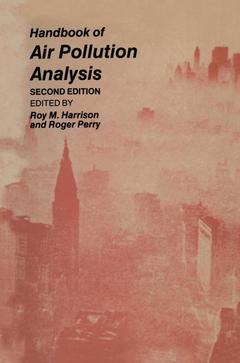Description
Handbook of Air Pollution Analysis, Softcover reprint of the original 1st ed. 1986
Coordinator: Harrison Roy M.
Language: English
Keywords
Publication date: 10-2011
634 p. · 15.5x23.5 cm · Paperback
634 p. · 15.5x23.5 cm · Paperback
Contents
/li>
1 General sampling techniques.- 1.1 Sampling goals and requirements.- 1.2 Sampling methods.- References.- 2 Air pollution meteorology.- 2.1 Introduction.- 2.2 Meteorological measurements.- 2.3 Outline of the more important features of the atmospheric transport and dispersion of pollutants.- 2.4 Calculation of the atmospheric transmission of pollutants.- 2.5 Examples of calculations using Gaussian models.- References.- 3 Air pollution chemistry.- 3.1 Introduction.- 3.2 Inorganic reactions.- 3.3 Reactions involving organic compounds.- 3.4 Gas-to-particle conversion.- 3.5 Conclusion.- References.- 4 Analysis of particulate pollutants.- 4.1 Introduction.- 4.2 Suspended material.- 4.3 Dustfall sampling.- 4.4 Physical techniques for classification of particulates.- References.- 5 Metal analysis.- 5.1 Introduction.- 5.2 Analysis of particulate matter.- 5.3 Gases and vapours.- References.- 6. Nitrogen and sulphur compounds.- 6.1 Introduction.- 6.2 Basic analytical techniques.- 6.3 Experimental section.- 6.4 Particulate compounds of S and N.- References.- 7 Secondary pollutants.- 7.1 Introduction.- 7.2 Basic analytical techniques for the analysis of gaseous secondary pollutants.- 7.3 Experimental section.- References.- 8 Hydrocarbons and carbon monoxide.- 8.1 Introduction.- 8.2 Volatile hydrocarbons.- 8.3 Hydrocarbon fraction of airborne particulate matter.- 8.4 Carbon monoxide.- References.- 9 Halogen compounds.- 9.1 Fluorides.- 9.2 Chlorine.- 9.3 HCl and particulate chloride.- 9.4 Bromides.- 9.5. Halogenated hydrocarbons.- 10. Remote monitoring techniques.- 10.1 Introduction.- 10.2 Correlation spectroscopy.- 10.3 Single wavelength lidar.- 10.4 Differential lidar.- 10.5 Laser safety.- 10.6 Long pathlength absorption spectroscopy (this section by A.M. Winer).- 10.7 Meteorological measurements.- 10.8 The use of remote sensing in field studies.- 10.9 Conclusions.- Acknowledgements.- References.- 11. Physico-chemical speciation techniques for atmospheric particles.- 11.1 Introduction.- 11.2 Speciation methods.- References.- 12. Analysis of precipitation.- 12.1 Introduction.- 12.2 Sampling.- 12.3 Analysis.- 12.4 Concluding comment.- References.- 13. Low-cost methods for air pollution analysis.- 13.1 Introduction.- 13.2 General considerations.- 13.3 Selected methods for measuring air pollutants.- 13.4 Additional considerations for selecting a low-cost air pollution measurement method.- References.- 14 Planning and execution of an air pollution study.- 14.1 Introduction.- 14.2 Objectives of the monitoring programme.- 14.3 Effluent history from source to receptor.- 14.4 The monitoring network.- 14.5 The design of pollution monitoring systems.- 14.6 Data handling.- 14.7 Analysis of results.- 14.8 Examples of monitoring networks and data presentations.- Acknowledgements.- References.- 15 Quality assurance in air pollution monitoring.- 15.1 Quality and quality assurance.- 15.2 Definitions.- 15.3 Elements of the monitoring chain.- 15.4 Site location and character.- 15.5 Sampling line integrity.- 15.6 Instrument performance.- 15.7 Calibration.- 15.8 Discussion and further checks.- References.
© 2024 LAVOISIER S.A.S.




